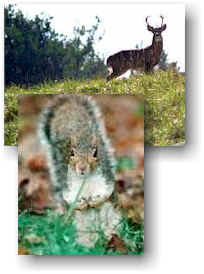Mammals

In 1994, as part of sitewide biological surveys, observations of mammals or evidence of their presence were made seasonally along transects and during timed or time-constrained searches into selected habitats. Incidental observations of mammals were also recorded while moving from site to site, walking to and from sites, and while cruising roads. A total of 14 mammal species were identified during observations. The white-tailed deer was the most common mammal observed by sight. They were found in all natural habitats and were also seen in developed areas. Deer were observed feeding on grasses along roadways and lawn edges. Within forests and wetlands, deer browsed on saplings, grasses, shrubs, and green brier. This species relies heavily on the annual crop of acorns produced by the various oak species on site. White-tailed deer were less common in the pine plantation areas than in the pitch pine/oak forest and wetland sites. Within these areas they were more common near edges where habitats changed, especially mowed grassy edges bordering roadsides. No deer hunting (gun or bow) is allowed on the BNL property. Hunting is allowed in cooperative hunting areas adjacent the site to the east. The hunting restriction has contributed to the large deer population on site.
Other species commonly observed on site but in low numbers were raccoon, muskrat, cottontail rabbits, gray squirrel, eastern chipmunk and red fox. White-footed mouse and other small mammal signs were observed throughout the site in various habitats except grasslands and mowed areas. Individual meadow voles or indications of their presence were observed in fields and emergent wetland areas where they are common. Other species including woodchuck, pine vole, and meadow jumping mouse were also observed on site.
Except for white-tailed deer, most mammals, including eastern cottontail, woodchuck, gray squirrel, and eastern chipmunk, were less common than expected on the BNL site. Certain species such as mink and weasel may be on site, but probably in very low numbers, as no evidence of their presence has been observed. Opossum and striped skunk were not seen during surveys, but have been observed by field sampling teams.
BNL Mammals
Bats
- Big Brown Bat (Eptesicus fuscus)
- Eastern Red Bat (Lasiurus borealis)
- Eastern Small-footed Bat (Myotis leibii)
- Hoary Bat (Lasiurus cinereus)
- Little Brown Bat (Myotis lucifugus)
- Northern Long-eared Bat (Myotis septentrionalis)
- Silver-haired Bat (Lasionycteris noctivagans)
Larger Mammals
- Eastern Cottontail Rabbit (Sylvilagus floridanus)
- Feral Cat (Felis domesticus)
- Gray Fox (Urocyon cinereoargenteus)
- Gray Squirrel (Sciurus carolinensis)
- Long-tailed Weasel (Mustela frenata)
- Muskrat (Ondatra zibethicus)
- Raccoon (Procyon lotor)
- Red Fox (Vulpes fulva)
- Striped Skunk (Mephitis mephitis)
- Virginia Opossum (Didelphis virginiana)
- White-tailed Deer (Odocoileus virginianus)
- Woodchuck (Marmota monax)
Smaller Mammals
- Eastern Chipmunk (Tamias striatus)
- Eastern mole (Scalopus aquaticus)
- House Mouse (Mus musculus)
- Least Shrew (Cryptotis parva)
- Masked Shrew (Sorex cinereus)
- Meadow Jumping Mouse (Zapus hudsonius)
- Meadow vole (Microtus pennsylvawcus)
- Northern Short-tailed Shrew (Blarina brevicauda)
- Pine vole (Microrus pinetorum)
- Southern flying squirrel (Glaucomys Volans)
- White-footed mouse (Peromyscus leucopus)


